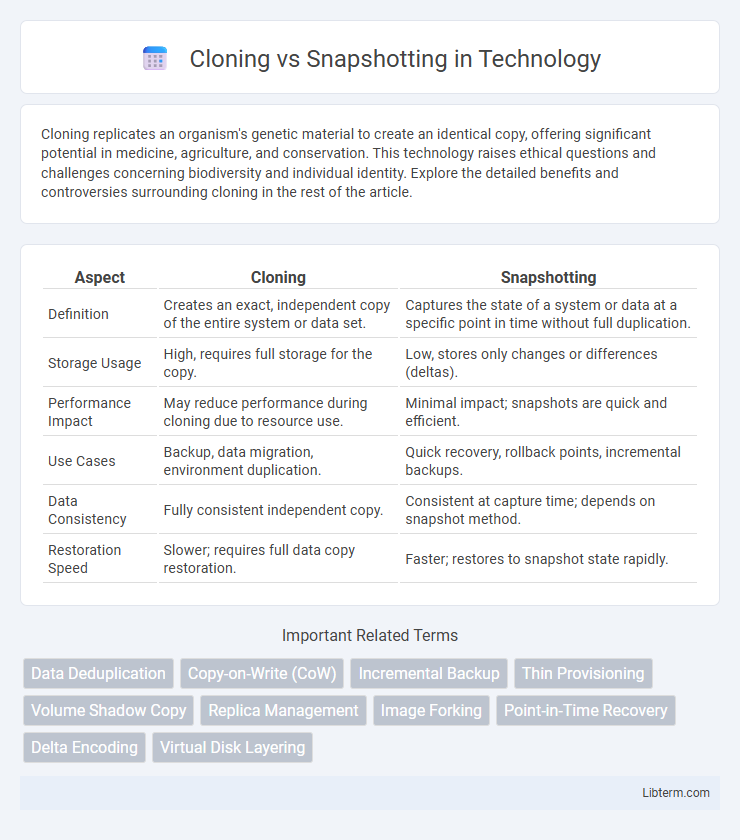Cloning replicates an organism's genetic material to create an identical copy, offering significant potential in medicine, agriculture, and conservation. This technology raises ethical questions and challenges concerning biodiversity and individual identity. Explore the detailed benefits and controversies surrounding cloning in the rest of the article.
Table of Comparison
| Aspect | Cloning | Snapshotting |
|---|---|---|
| Definition | Creates an exact, independent copy of the entire system or data set. | Captures the state of a system or data at a specific point in time without full duplication. |
| Storage Usage | High, requires full storage for the copy. | Low, stores only changes or differences (deltas). |
| Performance Impact | May reduce performance during cloning due to resource use. | Minimal impact; snapshots are quick and efficient. |
| Use Cases | Backup, data migration, environment duplication. | Quick recovery, rollback points, incremental backups. |
| Data Consistency | Fully consistent independent copy. | Consistent at capture time; depends on snapshot method. |
| Restoration Speed | Slower; requires full data copy restoration. | Faster; restores to snapshot state rapidly. |
Understanding Cloning and Snapshotting
Cloning creates an exact copy of a virtual machine or data set, enabling independent use and modifications without affecting the original version. Snapshotting captures the state, data, and configuration of a system at a specific point in time, allowing for quick rollback but relying on the original data for full functionality. Clones consume more storage since they are full duplicates, whereas snapshots are more storage-efficient but can impact performance during extensive use.
Key Differences Between Cloning and Snapshotting
Cloning creates an exact, independent copy of a dataset or virtual machine, allowing for separate modifications without affecting the original, while snapshotting captures the state of a system at a specific point in time and depends on the original data for storage. Snapshots are typically faster to create and consume less storage initially, but cloning requires more time and space because it duplicates all data. Snapshots are primarily used for backup and quick rollback, whereas cloning supports testing, development, and scaling by providing fully isolated copies.
How Cloning Works: An Overview
Cloning works by creating an exact, independent copy of a virtual machine or data set, duplicating both the content and configuration without affecting the original source. This process involves copying the entire disk image, memory state, and system settings, enabling the clone to operate autonomously with its own unique identifiers. Cloning is widely used for rapid provisioning, testing, and backup solutions, offering a fully isolated environment that does not depend on the original VM or snapshot.
What Is Snapshotting in Data Management?
Snapshotting in data management captures the exact state of a system or data volume at a specific point in time, creating a read-only, space-efficient copy without duplicating the entire dataset. This method leverages copy-on-write technology to record only changes made after the snapshot, enabling quick data recovery and minimal storage overhead. Snapshots are essential for backup solutions, facilitating rapid restore operations and supporting consistent data states in complex applications.
Use Cases for Cloning and Snapshotting
Cloning is ideal for creating full, independent copies of virtual machines or databases, enabling rapid deployment for testing, development, and backup purposes without impacting the original system. Snapshotting excels in capturing point-in-time states of data or VMs with minimal storage overhead, making it suitable for quick recovery after software updates or configuration changes. Both methods enhance data protection strategies but serve different operational needs--cloning for full duplication and snapshotting for incremental state preservation.
Performance Impacts: Cloning vs Snapshotting
Cloning creates a full, independent copy of the original data, demanding more storage and processing power, which can impact system performance during creation but offers consistent read/write speeds afterward. Snapshotting captures the state of a dataset at a specific point in time using less storage by saving only changes, resulting in minimal creation overhead but potential performance degradation during extensive incremental writes or long snapshot chains. Choosing between cloning and snapshotting depends on the workload's need for speed, storage efficiency, and the frequency of data modifications.
Storage Requirements: Cloning vs Snapshotting
Cloning requires significantly more storage as it creates a full, independent copy of the original data, consuming equivalent disk space. Snapshotting utilizes a copy-on-write approach, storing only the changes since the snapshot was taken, which minimizes additional storage requirements. This makes snapshots more efficient for short-term data protection, while clones are better suited for tasks needing complete, standalone datasets.
Data Recovery and Backup Implications
Cloning creates an exact, independent replica of an entire storage volume, enabling quick data recovery by restoring the clone without affecting the original data, making it ideal for full backup scenarios. Snapshotting captures the state of a storage system at a specific point in time using incremental changes, minimizing storage use and enabling fast recovery of specific files or system states, but relies on the original data's continued integrity. Both techniques enhance backup strategies, with cloning providing complete redundancy and snapshotting offering efficient, space-saving recovery options.
Security Considerations for Clones and Snapshots
Cloning and snapshotting both create point-in-time copies of data, but security considerations differ significantly between them. Clones are independent full copies, which can increase the attack surface by multiplying access points if not properly secured, while snapshots are incremental and tied to the source data, reducing exposure but potentially inheriting vulnerabilities from the original. Proper access controls, encryption, and frequent audits are essential to safeguard both clones and snapshots from unauthorized access and data breaches.
Choosing Between Cloning and Snapshotting: Best Practices
Choosing between cloning and snapshotting depends on the specific use case and performance requirements, with cloning creating full, independent copies ideal for development and testing environments. Snapshotting offers efficient, incremental backups that save storage and enable quick recovery but may impact performance if used excessively. Best practices recommend using snapshots for short-term rollback and cloning for long-term, isolated environments to balance resource use and operational efficiency.
Cloning Infographic

 libterm.com
libterm.com